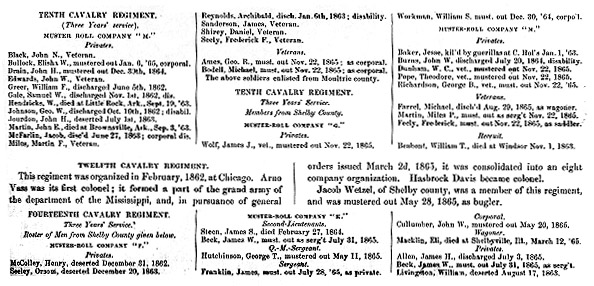TENTH CAVALRY REGIMENT.
Was organized November 25th, 1861, at Camp Butler, Springfield. James A. Barrett was its first Colonel, who resigned May 15th, 1862, and the same day Col. Dudley Wickersham was appointed Colonel of the regiment; on the 20th December, 1861, it moved to Qu
incy, Ill., and from thence to Benton Barracks, Mo. It operated in South-west Missouri, in the vicinity of Springfield and Marshfield, till November 13th, when it formed a part of the Army of the Frontier, and was in line of duty from Springfield, Mo., t
o Cane Hill, Arkansas. Took part in the battle of Prairie Grove, Ark., December 7th, 1862; was also at Jacksonport, Helena, and Old Town Landing; November 16th, marched with the expedition to the mouth of White river. Thence to Oakland, Miss., where it ha
d a skirmish with the enemy, and returned to Helena, December 7th, 1862. The term of service of the Tenth and Fifteenth regiments Illinois cavalry volunteers having expired, an order of consolidation was issued, January 26th, 1865, for the re-enlisted men
and recruits of the same, to be formed into twelve companies, and recognized as the Tenth Regiment Illinois Cavalry. The regiment was mustered out of service at San Antonio, Texas, and ordered to Springfield, Ill., and having served their country long an
d well, final payment and dicharge was made. The following are the soldiers from Moultrie and Shelby counties, who were members of this regiment.

Page 121

|| Return to Main Site Index ||

